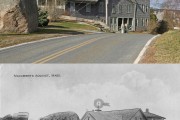Posted on April 24, 2018 by Jenny ONeill
Tannery account book 1769-1777
Account book details tannery activities, approximate dates 1769-1777 Calf skins, hides, leather, bark, horse skins, dog skins, sheep skins. Includes a list of initials used to identify the owner of the skins. Accession 2018.009 To view larger images, click once on image. First Daniel Last Allen Brand DA Peter Allen PA Constant Baly CPB Joseph […]
Continue Reading
